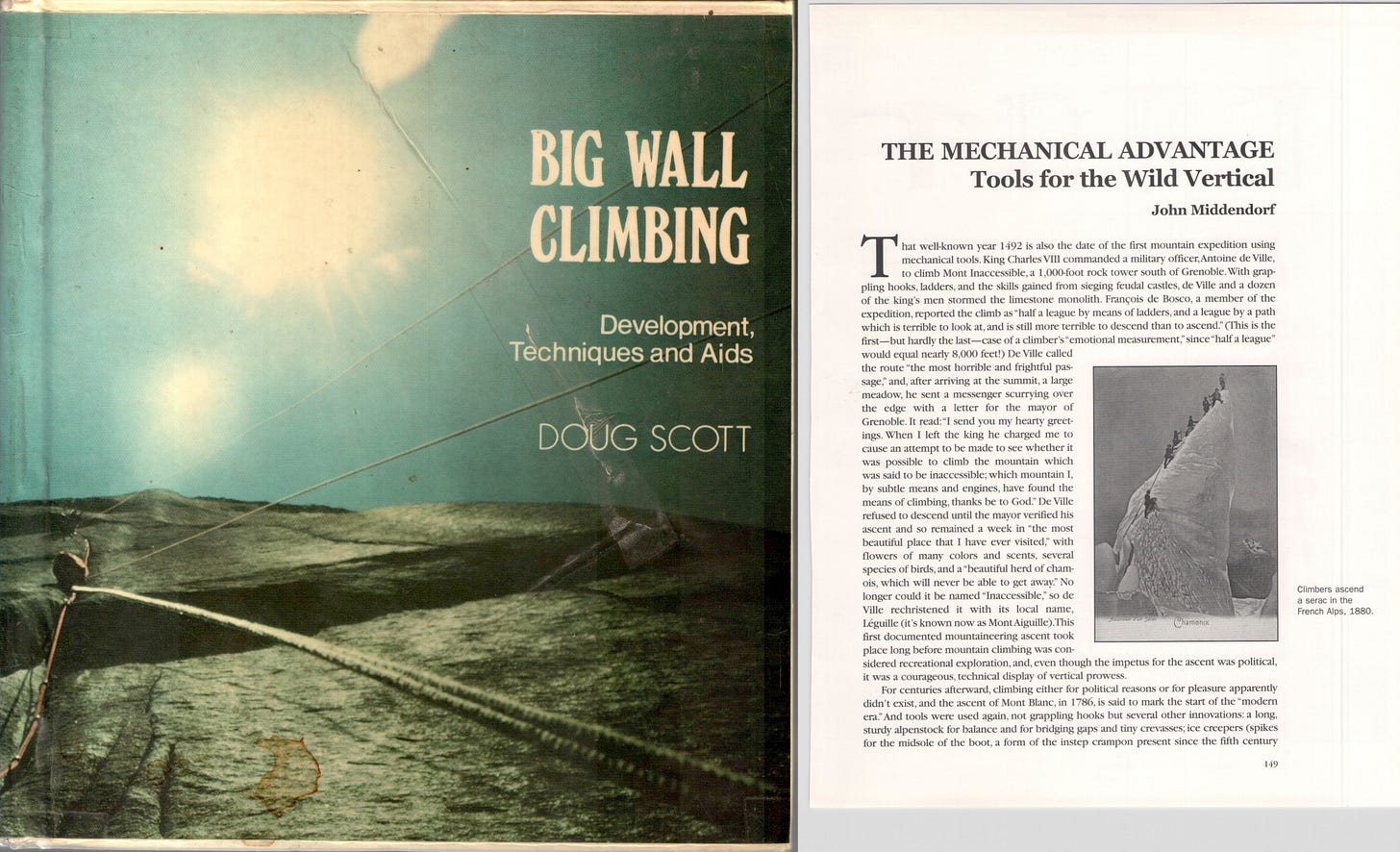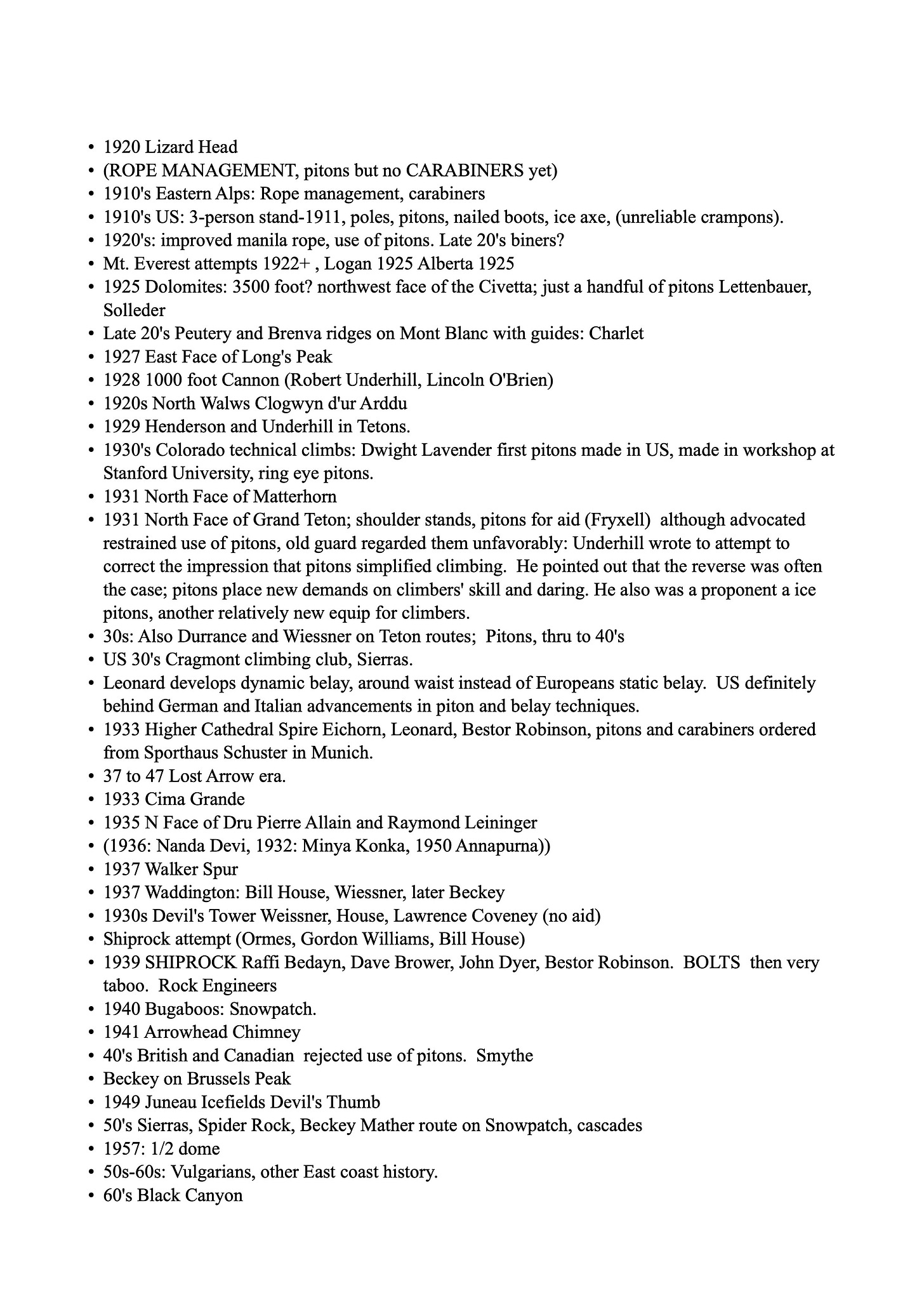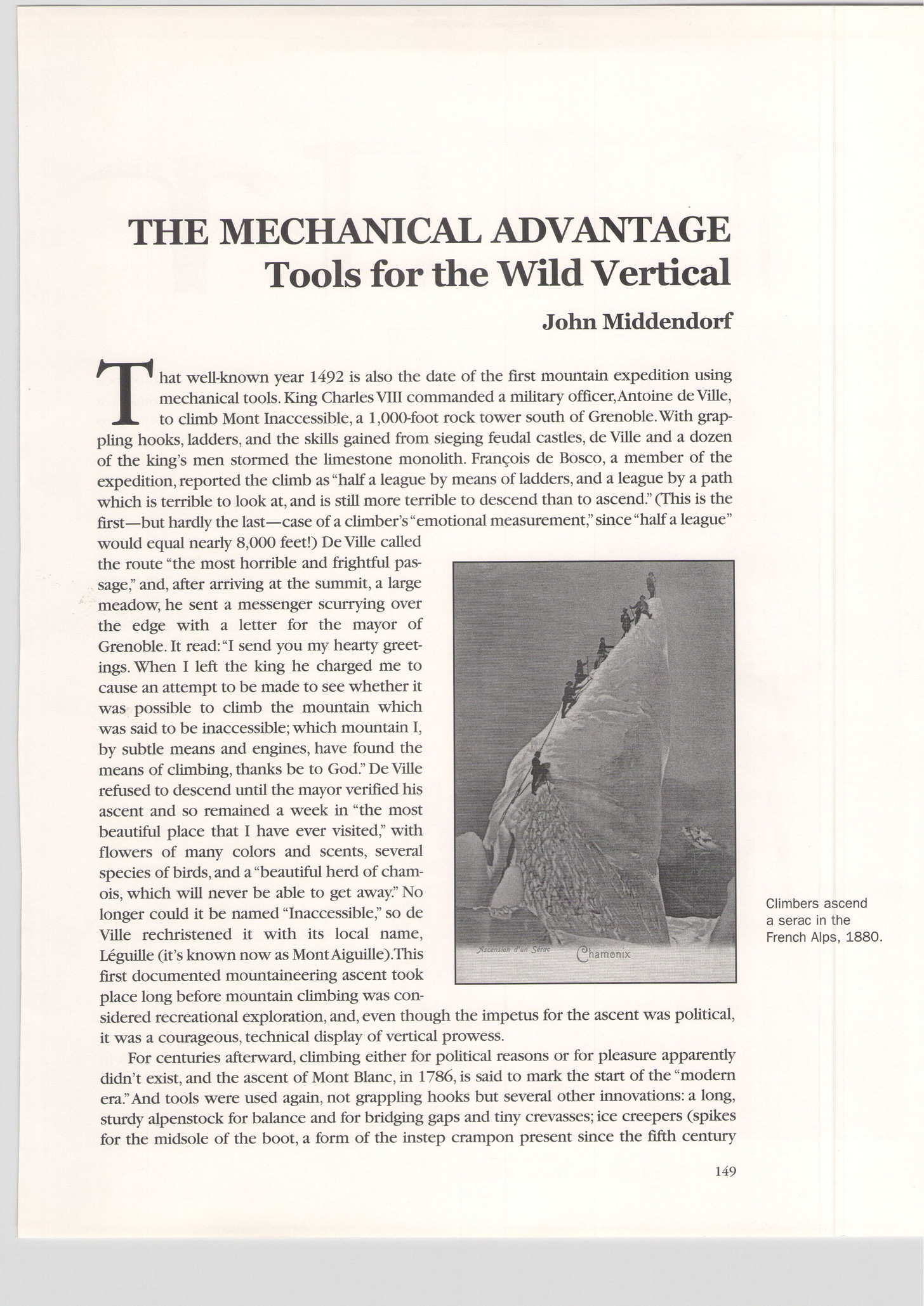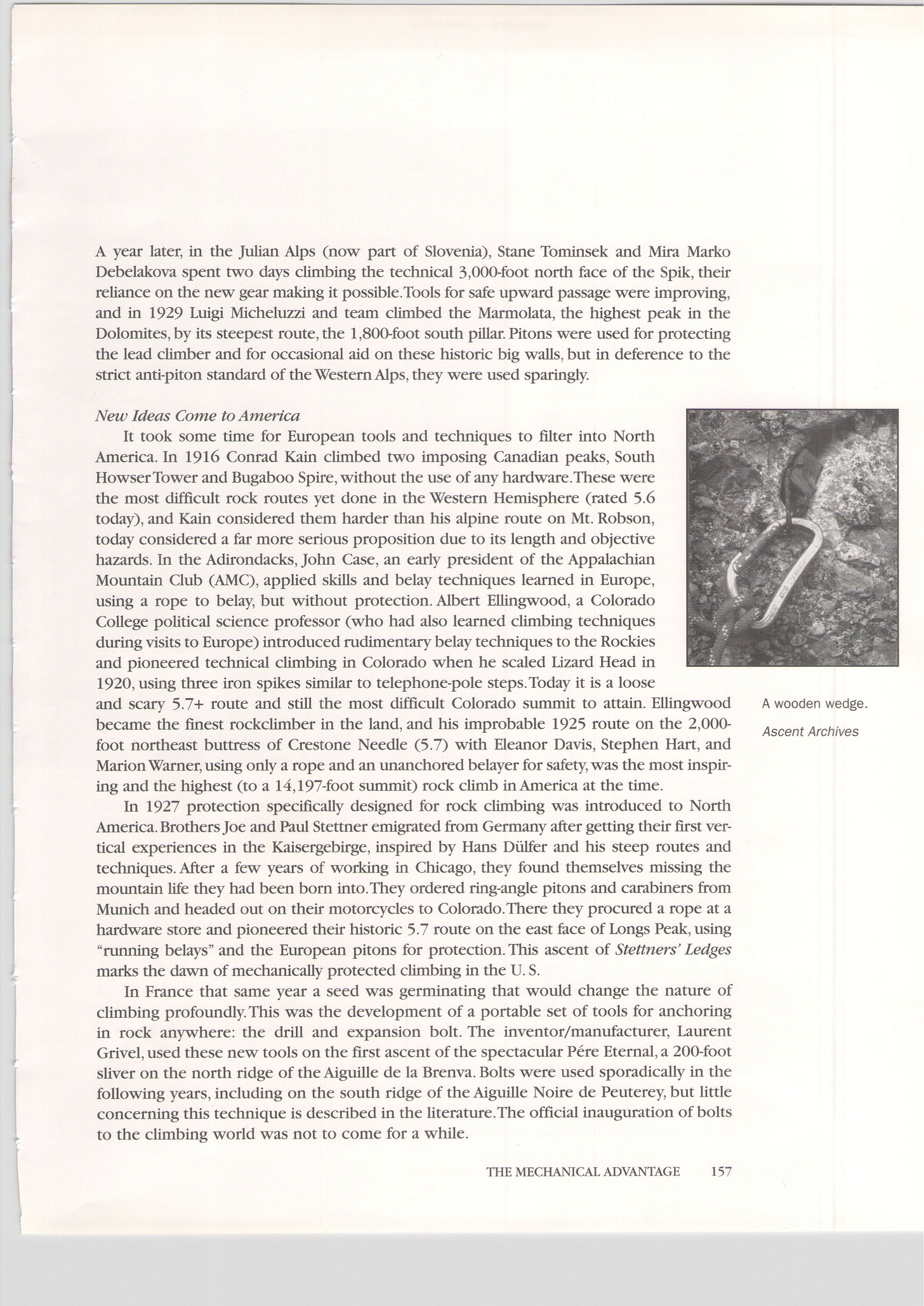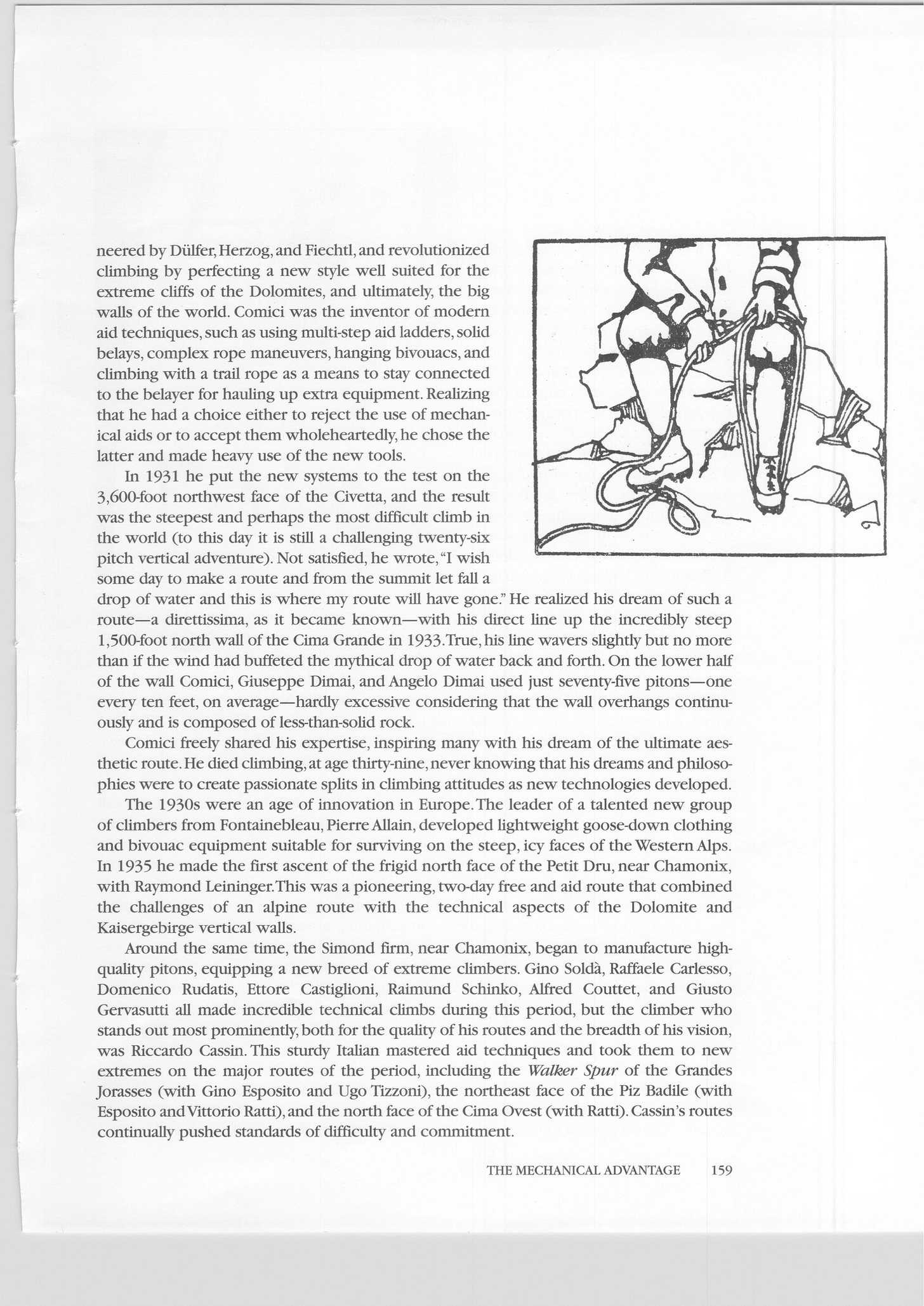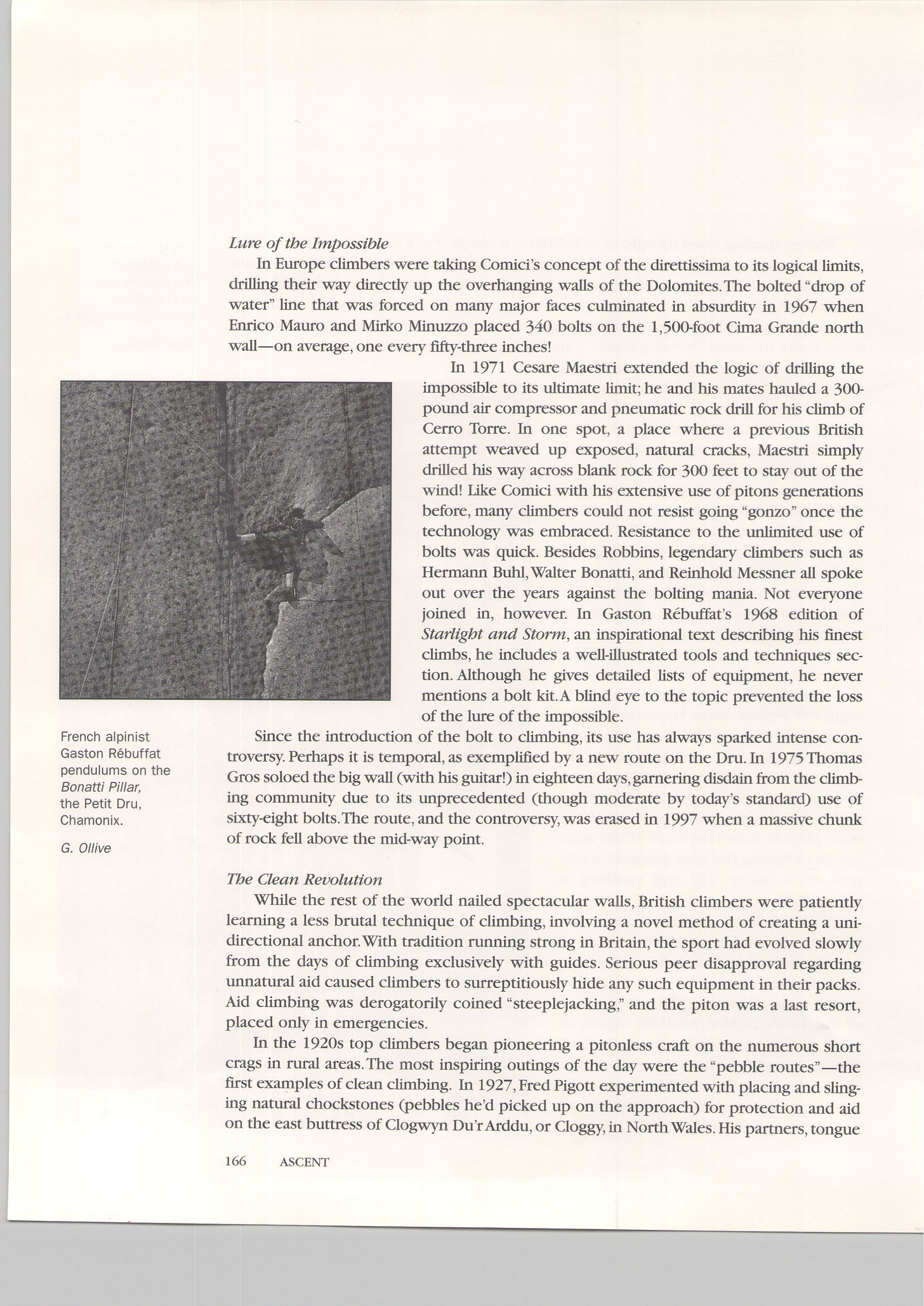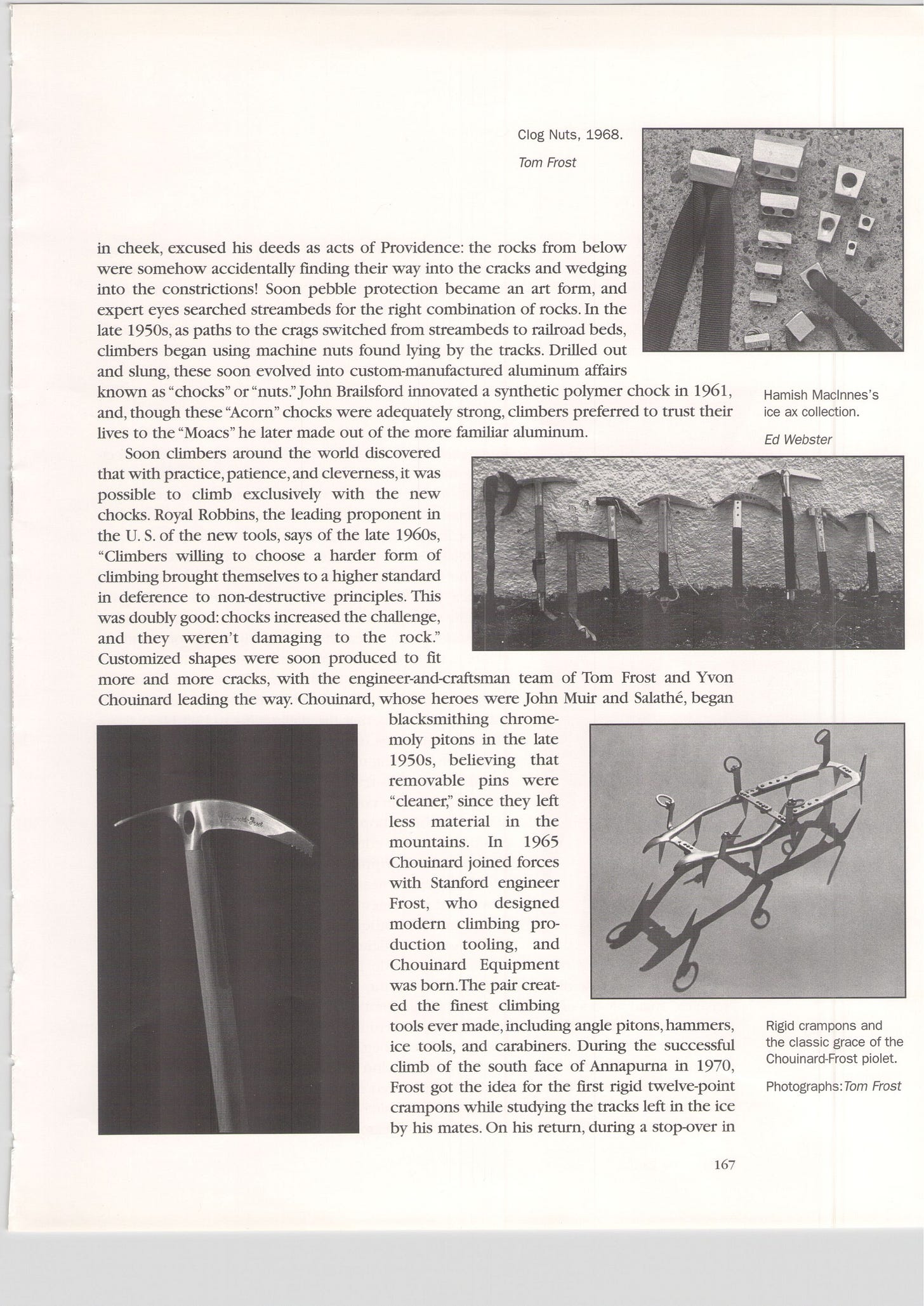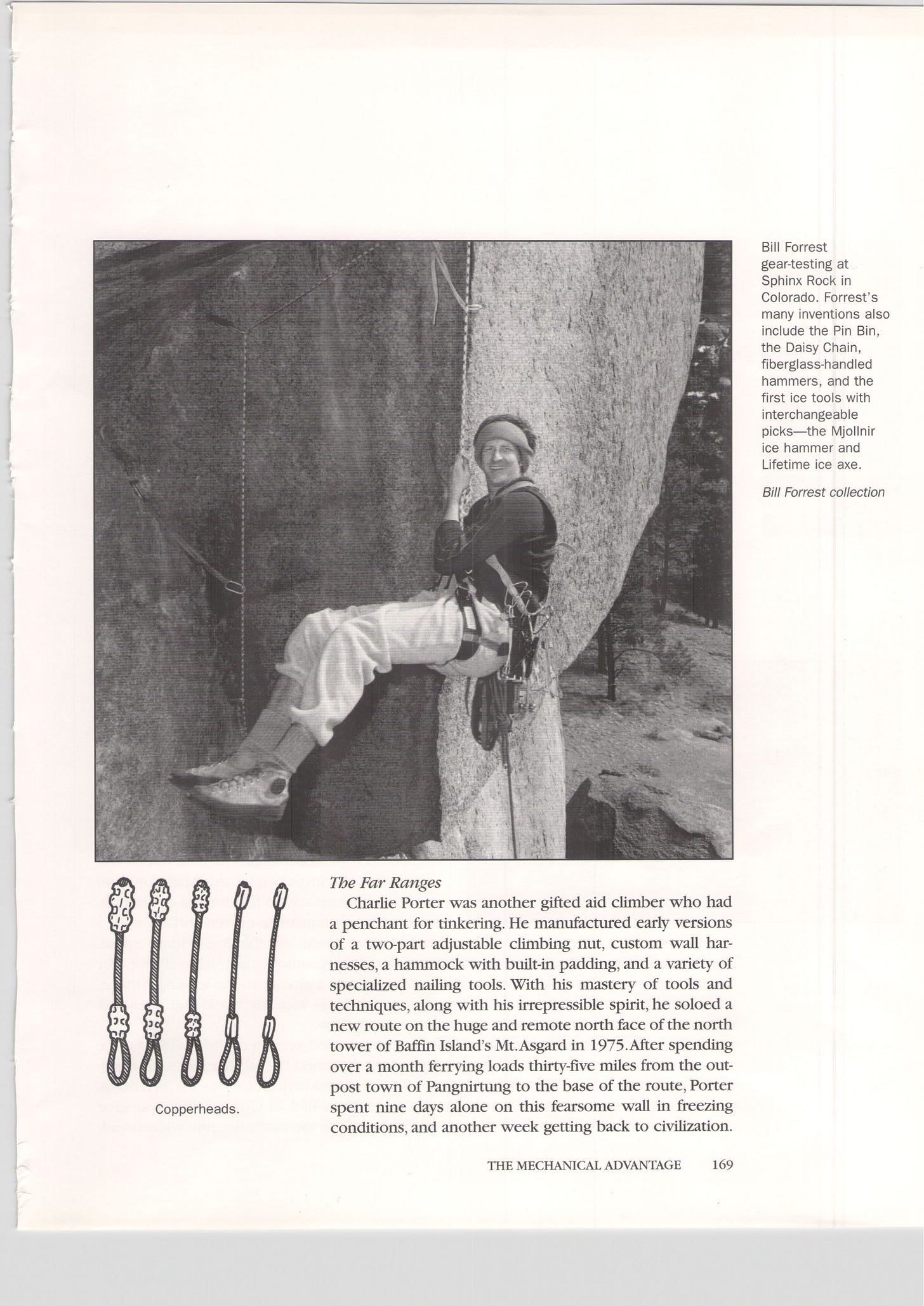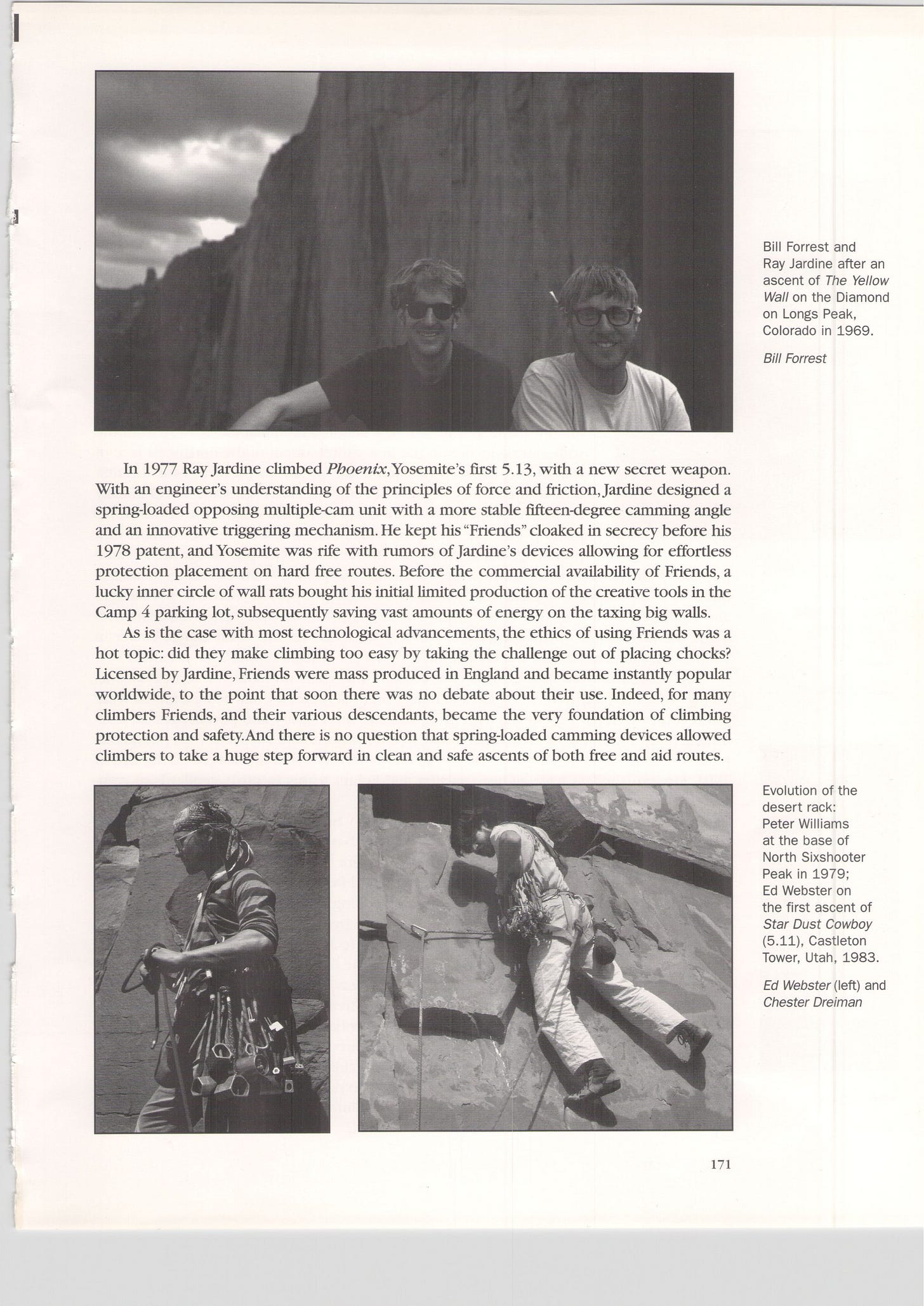Big wall history book notes (1994)
Mechanical Advantage series by John Middendorf
Buy the books here:
Volume 1: (mostly) European Tools and Techniques to the 1930s
Volume 2: (mostly) North American Climbing Tools and Techniques to the 1950s
Background
In the early 1990s, I was contracted by the American Alpine Club to write a book on bigwalls. I envisioned an update of Doug Scott’s Big Wall Climbing, originally published by Kaye&Ward (London) in 1974, and twenty years later it was still the most comprehensive book on the history and location of the world’s big walls.
In 1994, a new AAC editor changed my book-writing contract to only writing about North American big walls. I really struggled with this, as the history of big walls can only really be told globally, but I resigned to the task, and started to compile an outline (below). I could never get a good start on the writing of it, and eventually, the AAC asked me to return the advance, which I did, and now I understand better the problem with writing a book about only North American advances, as the story of bigwall climbing is full of global interconnections. All the material I have written in my past 16-months of researching the tools and techniques of big wall climbing would have had to be compressed into an Appendix. It is no wonder to me now why I couldn’t get this USA-centric book off the ground (and glad I did not). Here was the book-to-be:
Footnote: all my notes for the global version of the book eventually became the 25-page article “The Mechanical Advantage, Tools for the Wild Vertical”, published by the Sierra Club in 1999, which outlined major breakthroughs from pre-history to the then-present time (see Appendix). That article, in turn, has been the basis of this current article series, to research a little deeper into the oft-told history.
OUTLINE OF NORTH AMERICAN BIG WALL CLIMBING
(as presented in 1994)
As a history book, this book would have been very boring, both to write and to read, focused mainly on incremental changes of human endeavor, each wall topping the last in terms of technical difficulty, and many routes with the same old stories told again and again. On the other hand, it might have been a good North American guidebook, but I wasn’t really interested in creating a bigwall guide, as lists and details of routes, bigwall areas, and tips on getting to places like the Dungee basecamp on the Baltoro in Pakistan I had already published in detail on my bigwalls.net website, and this information was well used by many climbers looking for new objectives in the 1990s.
For this series, it is much more interesting to track the acceptance of the changing climbs and challenges, and all the creativity brought in by climbers from all around the world, with disparate goals and motivations on seeking new challenges in the mountains. The tool-using history of humans includes those for climbing vertical rocks, and offers interesting examples of ingenuity.
So the next chapters will be a little different, but many of the routes listed above will be included as they are important markers for the development of tools and techniques. I might take a pause on research for a short time, so posting this now to remind me!
1920s -1930s Research Organisation

Appendix: Original Mechanical Advantage as published in Ascent 1999:
A Historical Guide to North American Big Wall Climbing (1994 notes)
by John Middendorf 208 S. Main Hurricane, UT 84737
Foreword by Royal Robbins or Jim Bridwell
Chapter 1: Introduction
Chapter 2: Early Development of big wall climbing in North America
Chapter 3: Early Yosemite (pre-1974)
Chapter 4: Modern Yosemite
Chapter 5: High Sierra
Chapter 6: The High Plains/Rocky Mountains
Chapter 7: Southwest Deserts
Chapter 8: Western Canada
Chapter 9: Alaska
Chapter 10: Baffin Island
Chapter 11: The East Coast
Appendix A:Parallel big wall developments outside of North America.
Appendix B: Gear and techniques for big wall climbing.
Appendix C: Guidebook and other sources of information.
Appendix D: Selected Readings.
Development Areas (pre-40's)
North Face of Grand Teton
Devil's Tower
Shiprock and Agathala
Taquitz
Canadian areas
Early Yosemite (10 routes)
Half Dome Southwest Face: Salathe route
Lower Cathedral Spire: Eichorn Route
Lost Arrow Chimney
Half Dome NW Face (1957)
The Nose 1958
West Buttress 1963
Mt. Watkins South Face 1964
North American Wall 1964
Half Dome South Face
Cosmos
Heart Route 1970
The Shield 1972
Mescalito 1973
Modern Yosemite (10 routes)
Pacific Ocean Wall
Jolly Roger
Tribal Rite
Iron Hawk
Native Son
Zenyatta Mendatta
Wyoming Sheep Ranch
Sea of Dreams
Half Dome: Queen of Spades
Half Dome: The White Room
OTHER YOSEMITE WALLS MAY BE INCLUDED
High Sierra
Mt. Conness-Harding Route
Mt. Whitney-East Face
Kings Canyon/Sequoia: Watchtower
Kings Canyon/Sequoia: Angel's Wing
The High Plains/Rocky Mountains
Black Canyon of the Gunnison: Hallucinogen Wall
Black Canyon of the Gunnison: The Dragon
Longs Peak: D1 (1960 route)
Longs Peak: modern route.
Mt. Hooker: Robbins Route
Mt. Hooker: The Third eye
Montana: Beartooths route (?)
Liberty Bell: Thin Red Line or Independence Route
Southwest Deserts
Zion: Great White Throne
Zion: Abraham
Arches National Park
Fisher Towers: Titan: Sundevil or Kor route
Fisher Towers: one of the modern horrorshows
Redrocks-Mt. Wilson or Rainbow Wall
Baboquivari: Spring route, Cradle of Stone
El Trono Blanco, Mexico
Western Canada
Squamish Chief routes
Bugaboo routes
Coast Range: Mt. Combatant
Canadian Rockies: North Twin (Lowe Route)
Logan Mountains: Mt. Proboscis: Robbins Route and Yukon Tears
Logan Mountains: Lotus Flower Tower and/or Mt. Harrison Smith
ALASKA
Devil's Thumb <Devil's Paw A4?>
Mt. Hunter: Child/Kennedy route (Wall of Shadows)
Ruth Gorge: East Face of Moose's Tooth (Stump/Bridwell)
Ruth Gorge: Mt. Dickey (Orgler)
Ruth Gorge: Eye Tooth (1989 route) or Broken Tooth
Cathedral Spires: Middle Tripple
Cathedral Spires: East Face of Kichatna Spire (Wollum/Denz 1982)
Little Switzerland: The Throne (Manica/DeDona 1991)
BAFFIN ISLAND
Thor
Asgard
Northern Fjords
The East Coast
Southeast: Whitesides route
Cannon Cliff: the Ghost
Cathedral Ledges route
Routes in eastern Canada (Quebec)
Outline copyright © John Middendorf 1994. Not to be reproduced or distributed without my permission.
Old Chronology (1999):
1920 Lizard Head
(ROPE MANAGEMENT, pitons but no CARABINERS yet)
1910's Eastern Alps: Rope management, carabiners
1910's US: 3-person stand-1911, poles, pitons, nailed boots, ice axe, (unreliable crampons).
1920's: improved manila rope, use of pitons. Late 20's biners?
Mt. Everest attempts 1922+ , Logan 1925 Alberta 1925
1925 Dolomites: 3500 foot? northwest face of the Civetta; just a handful of pitons Lettenbauer,
Solleder
Late 20's Peutery and Brenva ridges on Mont Blanc with guides: Charlet
1927 East Face of Long's Peak
1928 1000 foot Cannon (Robert Underhill, Lincoln O'Brien)
1920s North Walws Clogwyn d'ur Arddu
1929 Henderson and Underhill in Tetons.
1930's Colorado technical climbs: Dwight Lavender first pitons made in US, made in workshop at
Stanford University, ring eye pitons.
1931 North Face of Matterhorn
1931 North Face of Grand Teton; shoulder stands, pitons for aid (Fryxell) although advocated
restrained use of pitons, old guard regarded them unfavorably: Underhill wrote to attempt to correct the impression that pitons simplified climbing. He pointed out that the reverse was often the case; pitons place new demands on climbers' skill and daring. He also was a proponent a ice pitons, another relatively new equip for climbers.
30s: Also Durrance and Wiessner on Teton routes; Pitons, thru to 40's
US 30's Cragmont climbing club, Sierras.
Leonard develops dynamic belay, around waist instead of Europeans static belay. US definitely
behind German and Italian advancements in piton and belay techniques.
1933 Higher Cathedral Spire Eichorn, Leonard, Bestor Robinson, pitons and carabiners ordered
from Sporthaus Schuster in Munich.
37 to 47 Lost Arrow era.
1933 Cima Grande
1935 N Face of Dru Pierre Allain and Raymond Leininger
(1936: Nanda Devi, 1932: Minya Konka, 1950 Annapurna))
1937 Walker Spur
1937 Waddington: Bill House, Wiessner, later Beckey
1930s Devil's Tower Weissner, House, Lawrence Coveney (no aid)
Shiprock attempt (Ormes, Gordon Williams, Bill House)
1939 SHIPROCK Raffi Bedayn, Dave Brower, John Dyer, Bestor Robinson. BOLTS then very
taboo. Rock Engineers
1940 Bugaboos: Snowpatch.
1941 Arrowhead Chimney
40's British and Canadian rejected use of pitons. Smythe
Beckey on Brussels Peak
1949 Juneau Icefields Devil's Thumb
50's Sierras, Spider Rock, Beckey Mather route on Snowpatch, cascades
1957: 1/2 dome
50s-60s: Vulgarians, other East coast history.
60's Black Canyon
Quote: 1963 American Alpine Journal, Yvon Chouinard.
Yosemite Valley will, in the near future, be the training ground for a new generation of super alpinists who will venture forth to the high mountains of the world to do the most aesthetic and difficult walls on the face of the earth.


